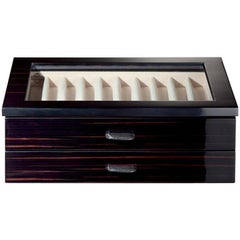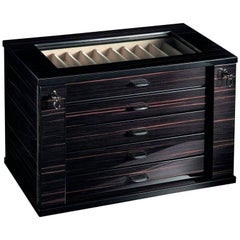Agresti Pen Box
21st Century and Contemporary Italian Modern Jewelry Boxes
Suede, Wood
21st Century and Contemporary Italian Modern Jewelry Boxes
Suede, Wood
People Also Browsed
21st Century and Contemporary Brazilian Mid-Century Modern Wall Lights a...
Stone, Quartz, Brass
Vintage 1960s Scandinavian Scandinavian Modern Tableware
Brass
21st Century and Contemporary Italian Modern Jewelry Boxes
Leather, Wood
Vintage 1960s American Mid-Century Modern Cabinets
Brass, Copper, Steel
Vintage 1980s Finnish Organic Modern Lounge Chairs
Fiberglass
Vintage 1940s American Mid-Century Modern Desks
Aluminum
Antique 19th Century Italian Apothecary Cabinets
Glass, Walnut
Vintage 1960s Italian Mid-Century Modern Decorative Boxes
Crystal, Metal
Antique Late 19th Century Italian Architectural Models
Brass
2010s Italian Swivel Chairs
Fur, Lambskin, Wood
Vintage 1960s European Decorative Boxes
Aluminum
21st Century and Contemporary French Wall Lights and Sconces
Bronze
Vintage 1960s American Mid-Century Modern Doors and Gates
Bronze, Steel
Vintage 1930s Austrian Art Deco Commodes and Chests of Drawers
Walnut, Spruce
Mid-20th Century American Brutalist Abstract Sculptures
Granite, Brass, Bronze
20th Century Italian Decorative Boxes
Malachite
Agresti for sale on 1stDibs
Luxury furniture brand Agresti has been known for its exquisite range of jewelry boxes, storage cabinets, safes and other case pieces since the postwar years. The Italian company is recognized internationally for its commitment to unparalleled craftsmanship in every piece that is produced in its factory in Florence.
Osvaldo and Pia Agresti established their company in 1949, when skilled craftspeople in the historic capital of Tuscany created modern case goods by hand for the fledgling brand. Today, Agresti is recognized for elegant but sturdy strongboxes equipped with complex and multiple key and tumbler locks and sophisticated biometric opening devices. Agresti watch boxes feature bulletproof glass fronts, leather pouches and innovative Swiss mechanisms that wind timepieces when not in use, while their game sets, crafted in red briar and polished ebony, are guaranteed to dazzle even the most seasoned chess champions.
Agresti furnishings are made of the world’s finest materials, including a range of leathers, mahogany, bird’s eye maple, brass and a rare metal called ruthenium. The elaborate interiors of the brand’s armoires and commodes — some of which feature brass-plated 24-karat gold hardware and high-level steel — frequently prove mind-boggling, offering an array of drawers and pull-out necklace bars. All cigar humidors have a removable tray, hygrometers and cedar lining, while some of Agresti’s luxury bar cabinets feature maple interiors and roomy compartments for glasses and bottles.
On 1stDibs, find Agresti decorative objects, storage cabinets, desk accessories and more.
A Close Look at Modern Furniture
The late 19th and early 20th centuries saw sweeping social change and major scientific advances — both of which contributed to a new aesthetic: modernism. Rejecting the rigidity of Victorian artistic conventions, modernists sought a new means of expression. References to the natural world and ornate classical embellishments gave way to the sleek simplicity of the Machine Age. Architect Philip Johnson characterized the hallmarks of modernism as “machine-like simplicity, smoothness or surface [and] avoidance of ornament.”
Early practitioners of modernist design include the De Stijl (“The Style”) group, founded in the Netherlands in 1917, and the Bauhaus School, founded two years later in Germany.
Followers of both groups produced sleek, spare designs — many of which became icons of daily life in the 20th century. The modernists rejected both natural and historical references and relied primarily on industrial materials such as metal, glass, plywood, and, later, plastics. While Bauhaus principals Marcel Breuer and Ludwig Mies van der Rohe created furniture from mass-produced, chrome-plated steel, American visionaries like Charles and Ray Eames worked in materials as novel as molded plywood and fiberglass. Today, Breuer’s Wassily chair, Mies van der Rohe’s Barcelona chair — crafted with his romantic partner, designer Lilly Reich — and the Eames lounge chair are emblems of progressive design and vintage originals are prized cornerstones of collections.
It’s difficult to overstate the influence that modernism continues to wield over designers and architects — and equally difficult to overstate how revolutionary it was when it first appeared a century ago. But because modernist furniture designs are so simple, they can blend in seamlessly with just about any type of décor. Don’t overlook them.
Finding the Right Jewelry-boxes for You
If you have jewelry, chances are you have an antique or vintage jewelry box. This simple item was born from a simple need. It offers jewelry lovers a place to store their most cherished treasures. The idea behind a good jewelry box is that precious items deserve a place of honor.
It’s no surprise, then, that jewelry boxes (also called jewelry caskets or trinket boxes) have existed for as long as we’ve worn jewelry. It’s among the most popular decorative boxes we have in our homes, and we can find early versions that date at least as far back as Ancient Egypt. All Egyptians adorned themselves with necklaces, rings, earrings and other accessories, and the era’s jewelry boxes resembled small treasure chests. Later, fine jewelry became cost prohibitive and the only people with jewelry boxes were those who could afford jewelry.
Following the Industrial Revolution, jewelry was no longer made by hand. Mass production and the demand of the growing middle class rendered jewelry more accessible. Jewelry of the Romantic period, which refers to early Victorian jewelry, is reflective of these economic shifts. Jewelry from this time tends to be feminine and ornate, and embellished with seed pearls, coral and turquoise. Naturally, it was stored in elaborate, decorative Victorian-era jewelry boxes that were sometimes crafted from hand-painted porcelain or sterling silver.
Nowadays, jewelry boxes do more than keep jewelry safe and organized. They’re popular collector’s items that have become as treasured as the contents themselves.
Designer jewelry boxes — Chanel jewelry boxes, Hermès jewelry boxes and others created by celebrated fashion labels — are widely sought by jewelry lovers who covet a chic case for their jewelry essentials. An eye-catching vintage jewelry box, which is at least 20 but less than 100 years old, is a valuable decorative object, a sign of luxury and elegance that adds character and texture to any bedroom. Some jewelry boxes are even embellished with a few jewels of their own.
If you’re not tucking your jewelry into a drawer or shallow tray atop your vanity, perhaps an Art Deco trinket box with charming brass hardware or a sculptural, hand-carved rosewood mid-century modern jewelry box lined with linen and velvet will do?
Today’s jewelry boxes come in a variety of styles and sizes and are made of metal, wood, plastic and other materials. Give your cherished jewelry the good home it deserves — find an extensive collection of antique and vintage jewelry boxes today on 1stDibs.




